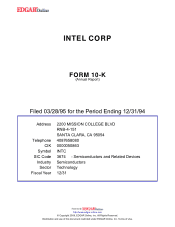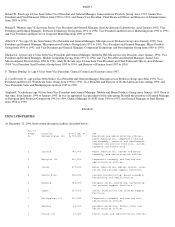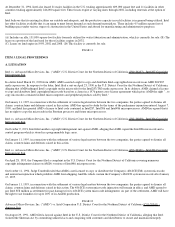Intel 1994 Annual Report Download - page 3
Download and view the complete annual report
Please find page 3 of the 1994 Intel annual report below. You can navigate through the pages in the report by either clicking on the pages listed below, or by using the keyword search tool below to find specific information within the annual report.
(1) Portions of Annual Report to Stockholders for fiscal year ended December 31, 1994-Items 5, 6, 7, 8 and 14.
(2) Portions of Proxy Statement dated March 14, 1995 -Items 10, 11, 12, and 13.
PAGE 2
PART I
ITEM 1. BUSINESS
INDUSTRY
Intel Corporation and its subsidiaries (collectively called "Intel," the "Company" or the "Registrant") operate in one dominant industry
segment. The Company designs, develops, manufactures and markets microcomputer components and related products at various levels of
integration.
Intel components consist of silicon-based semiconductors etched with complex patterns of transistors. Each one of these integrated circuits
(ICs) can perform the functions of thousands--even millions--of individual transistors, diodes, capacitors and resistors.
PRODUCTS
Intel's product strategy is twofold: the Company offers OEMs (original equipment manufacturers) a wide range of PC (personal computer)
building-block products to meet their needs, and offers PC users products that expand the capabilities of their systems and networks.
The Company's major products include microprocessors, chipsets, embedded processors and microcontrollers, flash memory chips, computer
modules and boards, network and communications products, personal conferencing products and scalable parallel processing computers.
MICROPROCESSORS. A microprocessor is the central processing unit of a PC. It processes system data and controls other devices in the
system, acting as the brains of a PC. Intel's 32-bit processors include the flagship Pentium(R) processor family and the Intel486(TM)
microprocessor family. Pentium processors are the latest extension of an architecture that is pervasive worldwide; the market research firm
Dataquest estimates that approximately 134 million PCs based on the Intel architecture are currently in use (compared to fewer than 20 million
PCs based on other architectures). The Company's strategy is to develop products in the Intel architecture family that are compatible with the
installed base of software applications.
Intel's developments in the art of semiconductor design and manufacturing have made it possible to decrease the feature size of circuits etched
into silicon. This permits a greater number of transistors to be fit on each silicon wafer, resulting in microprocessors that are smaller, faster
running, more energy efficient, and less expensive to make. These developments have also led to increasingly complex designs. Despite
rigorous testing standards, the Company cannot give assurances that any particular design will be flawless.
The Pentium processor family, fully binary compatible with previous generations of the Intel architecture, was introduced in 1993 with 60- and
66-MHz versions In 1994 Intel extended the family with 3.3V 75-, 90- and 100-MHz Pentium processors with enhanced power management
features and performance of up to 166 MIPS. These processors have enabled a broad variety of mainstream mobile, desktop, and server
systems based on the Pentium processor, and the PC market is transitioning rapidly to Pentium processor-based systems. Intel sells its
microprocessor products, including Pentium processors, at various levels of integration (chips, boards, systems and modules) depending on the
OEM's requirements (see "Computer Modules and Boards"). Intel expects to introduce higher performance versions of the Pentium processor
in 1995.
In early 1995, Intel previewed its sixth-generation processor, codenamed the P6, at the International Solid State Circuits Conference. The 5.5-
million- transistor P6, initially operating at 133 MHz, is projected to deliver approximately two times the performance of the 100-MHz
Pentium processor while maintaining binary software compatibility with previous generations of the Intel architecture. P6 technology is
expected to deliver workstation performance on the desktop while also enabling a new generation of multiprocessor servers. Systems based on
the P6 processor are expected to be available in the second half of 1995.
PAGE 3
Within the Intel486 microprocessor product family, certain designations such as SX, DX, DX2 and DX4 differentiate the processors from one
another. SX, DX and DX2 are used to designate the earlier generations of the family. Introduced in 1994, the IntelDX4(TM) processor, the
fastest member of the Intel486 microprocessor family, is popular in both entry-level home and business desktop systems and in mobile
computers. The IntelDX4 processor family offers up to 50 percent more performance than the 66-MHz IntelDX2(TM) microprocessor.
The OverDrive(R) family of processors provides CPU performance enhancements to Intel486 and Pentium processor-based systems. In early
1995, Intel introduced the Pentium OverDrive processor technology to Intel486 microprocessor-based systems.
Sales of the Intel486 microprocessor family comprised a majority of the Company's revenues and a substantial majority of its gross margin in
















